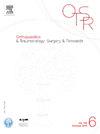Three-dimensional printing technique aids screw insertion into the sustentaculum tali of the internal fixation of intra-articular calcaneal fractures
IF 2.3
3区 医学
Q2 ORTHOPEDICS
引用次数: 0
Abstract
Introduction
Treating complex calcaneus fractures remains challenging. This study evaluated the influence of 3D printing and simulation on precision screw insertion into the calcaneus sustentaculum tali (ST).
Hypothesis
3D printing and simulation improve the treatment for calcaneal fracture.
Patients and methods
This retrospective cohort study included 85 patients admitted with 93 Sanders type II–IV intra-articular fractures from January 2015 to June 2020. Multi-slice computed tomography (MSCT) images were used in the conventional group, and MSCT data were used to construct a 3D model of the calcaneus to simulate screw insertion and verify parameter accuracy in the 3D group.
Results
The designed parameters (upward and backward oblique angles and screw-path length) were similar to the actual values in the 3D group (p = 0.428,0.287,0.585) but not in the conventional group (p = 0.01,0.002,0.023). The Maryland foot functional score, accuracy rate, and average screw number were higher and operative time was shorter in the 3D group (p = 0.005,0.007,0.000,0.000).
Discussion
Preoperative simulation using the 3D printing model helped guide the screws into the ST more accurately, lending better-quality treatment for Sanders type II–IV calcaneal fractures.
Level of proof
III; Retrospective case-control study.
三维打印技术帮助将螺钉插入踝关节内钙化骨折内固定的跗骨韧带
简介治疗复杂的小关节骨折仍具有挑战性。本研究评估了三维打印和模拟对将螺钉精确插入小关节(ST)的影响。假设:三维打印和模拟可改善小关节骨折的治疗:这项回顾性队列研究纳入了2015年1月至2020年6月期间收治的93例桑德斯II-IV型关节内骨折患者,共85例。常规组使用多层计算机断层扫描(MSCT)图像,3D组使用MSCT数据构建小腿骨三维模型,模拟螺钉插入并验证参数的准确性:结果:在三维组中,设计参数(向上和向后的斜角以及螺钉路径长度)与实际值相似(P=0.428,0.287,0.585),而在传统组中,设计参数与实际值不相似(P=0.01,0.002,0.023)。三维组的马里兰足功能评分、准确率和平均螺钉数量更高,手术时间更短(P=0.005,0.007,0.000,0.000):讨论:使用3D打印模型进行术前模拟有助于更准确地引导螺钉进入ST段,为Sanders II-IV型小头骨折提供更高质量的治疗:III;回顾性病例对照研究。
本文章由计算机程序翻译,如有差异,请以英文原文为准。
求助全文
约1分钟内获得全文
求助全文
来源期刊
CiteScore
5.10
自引率
26.10%
发文量
329
审稿时长
12.5 weeks
期刊介绍:
Orthopaedics & Traumatology: Surgery & Research (OTSR) publishes original scientific work in English related to all domains of orthopaedics. Original articles, Reviews, Technical notes and Concise follow-up of a former OTSR study are published in English in electronic form only and indexed in the main international databases.

 求助内容:
求助内容: 应助结果提醒方式:
应助结果提醒方式:


